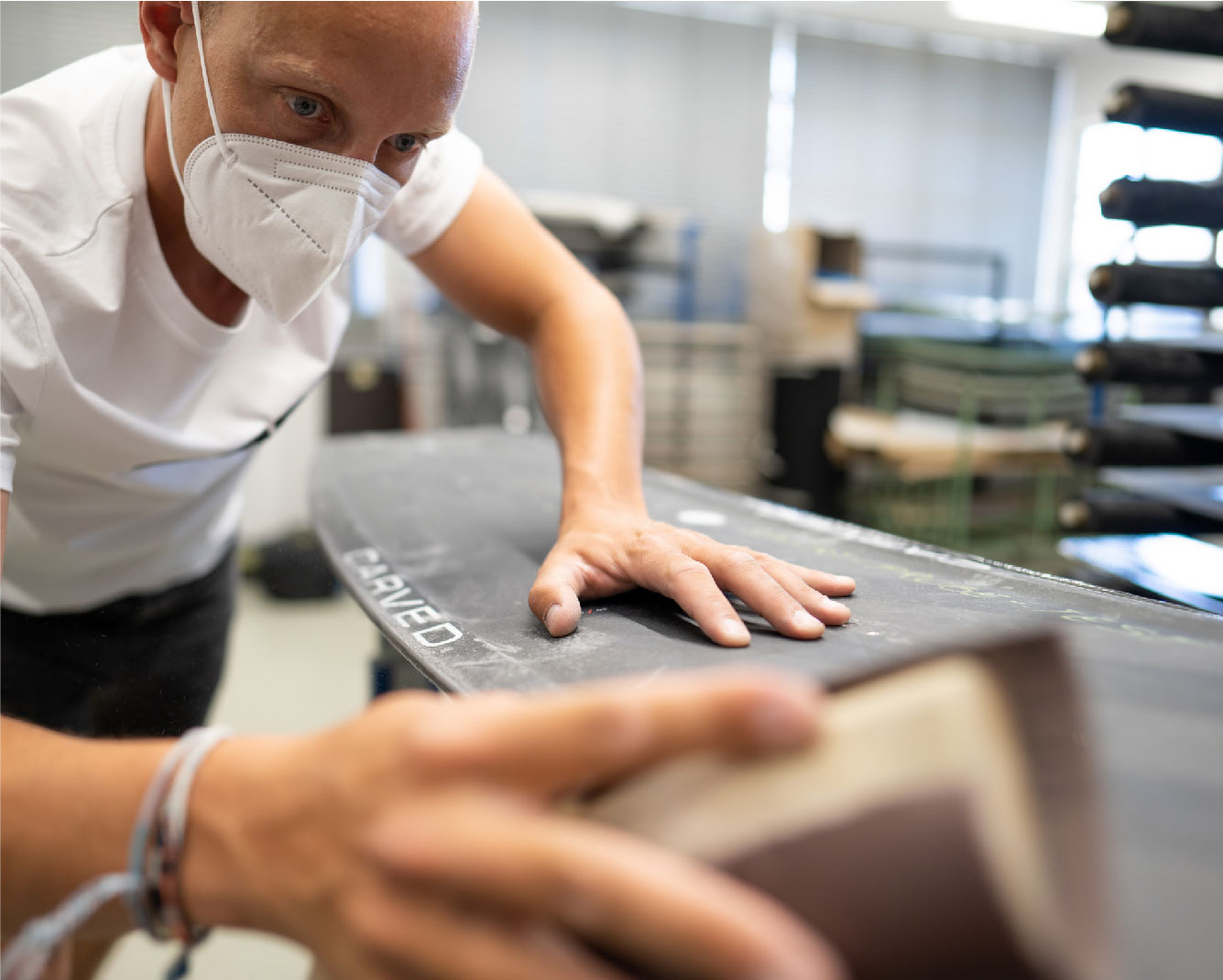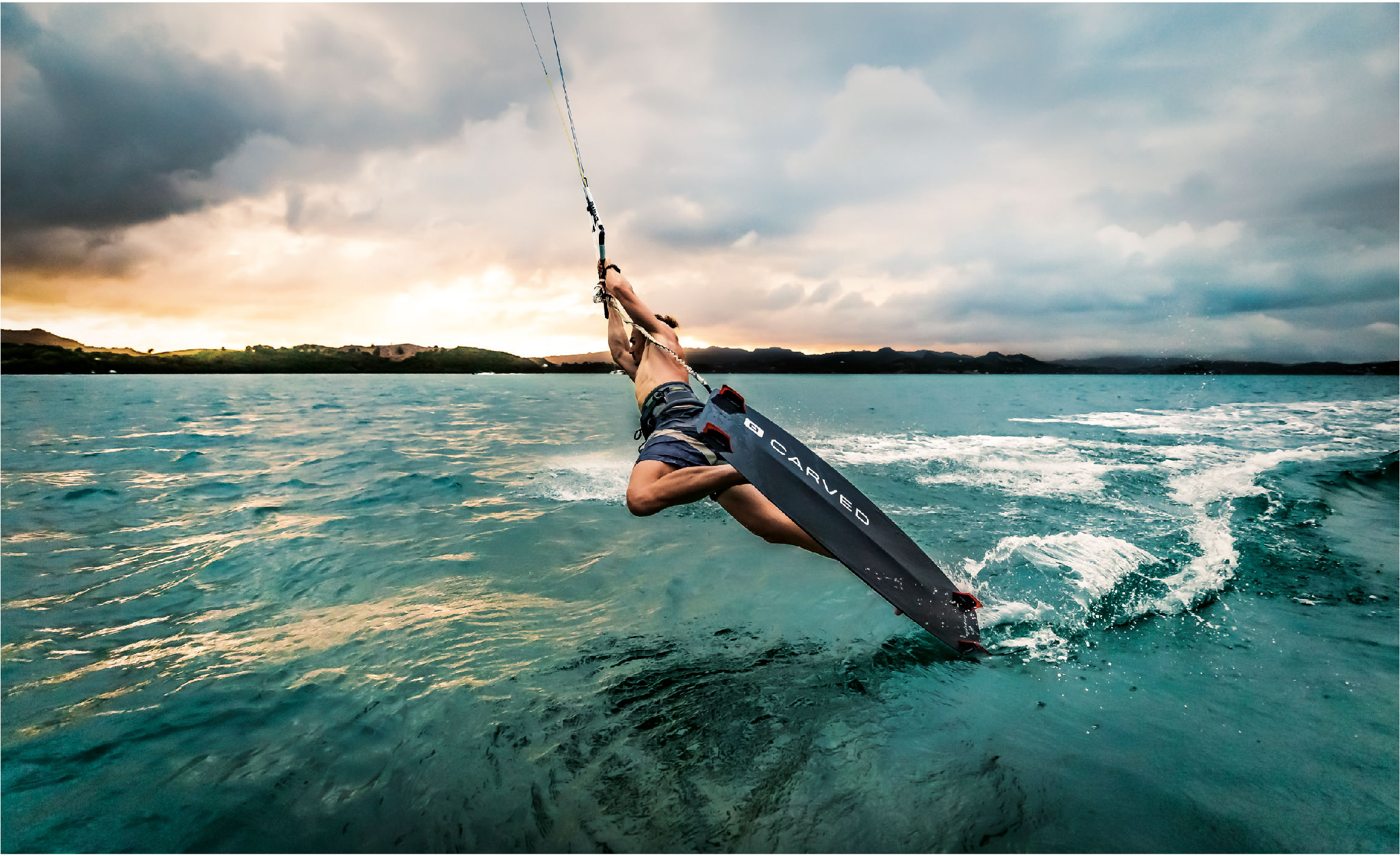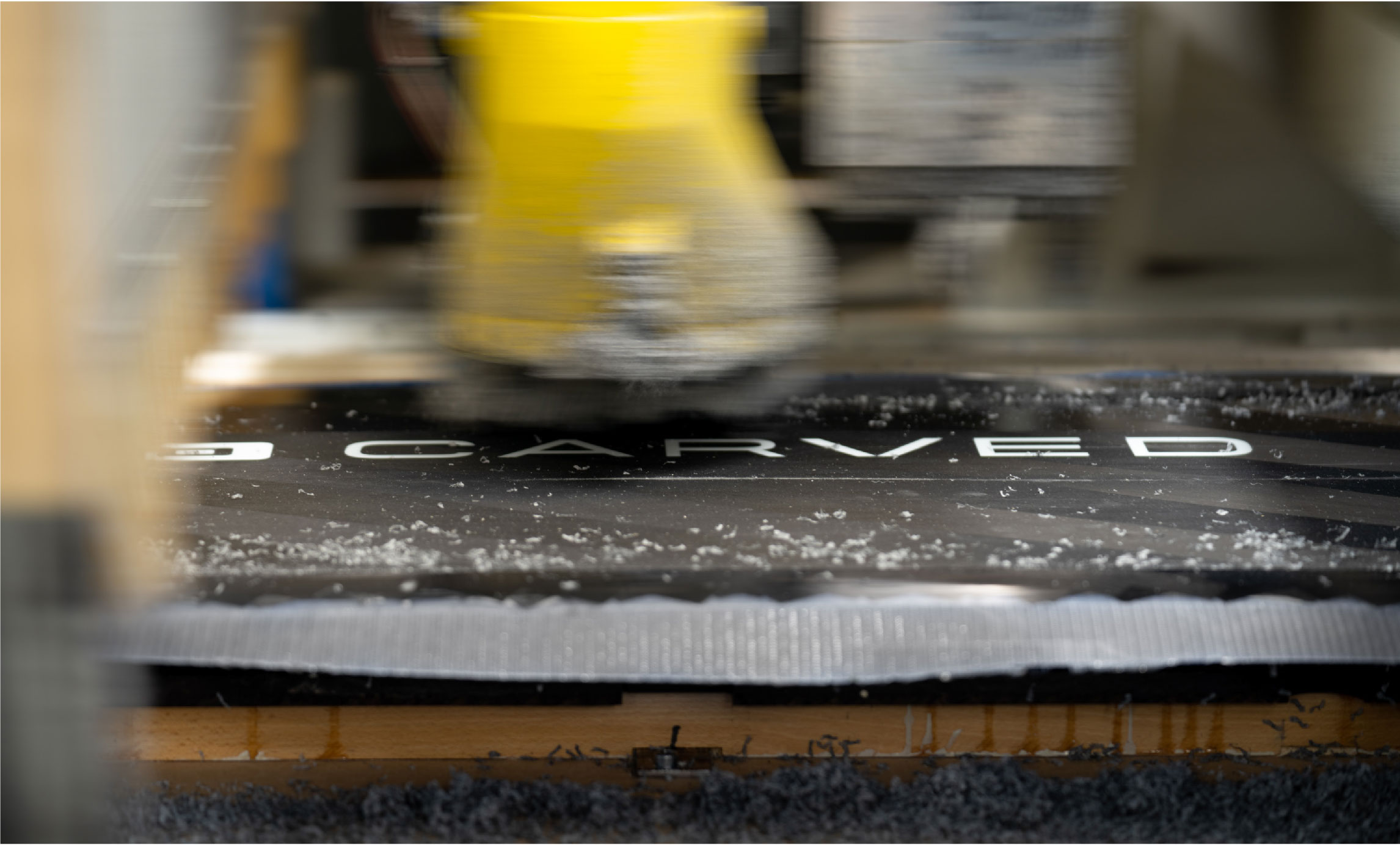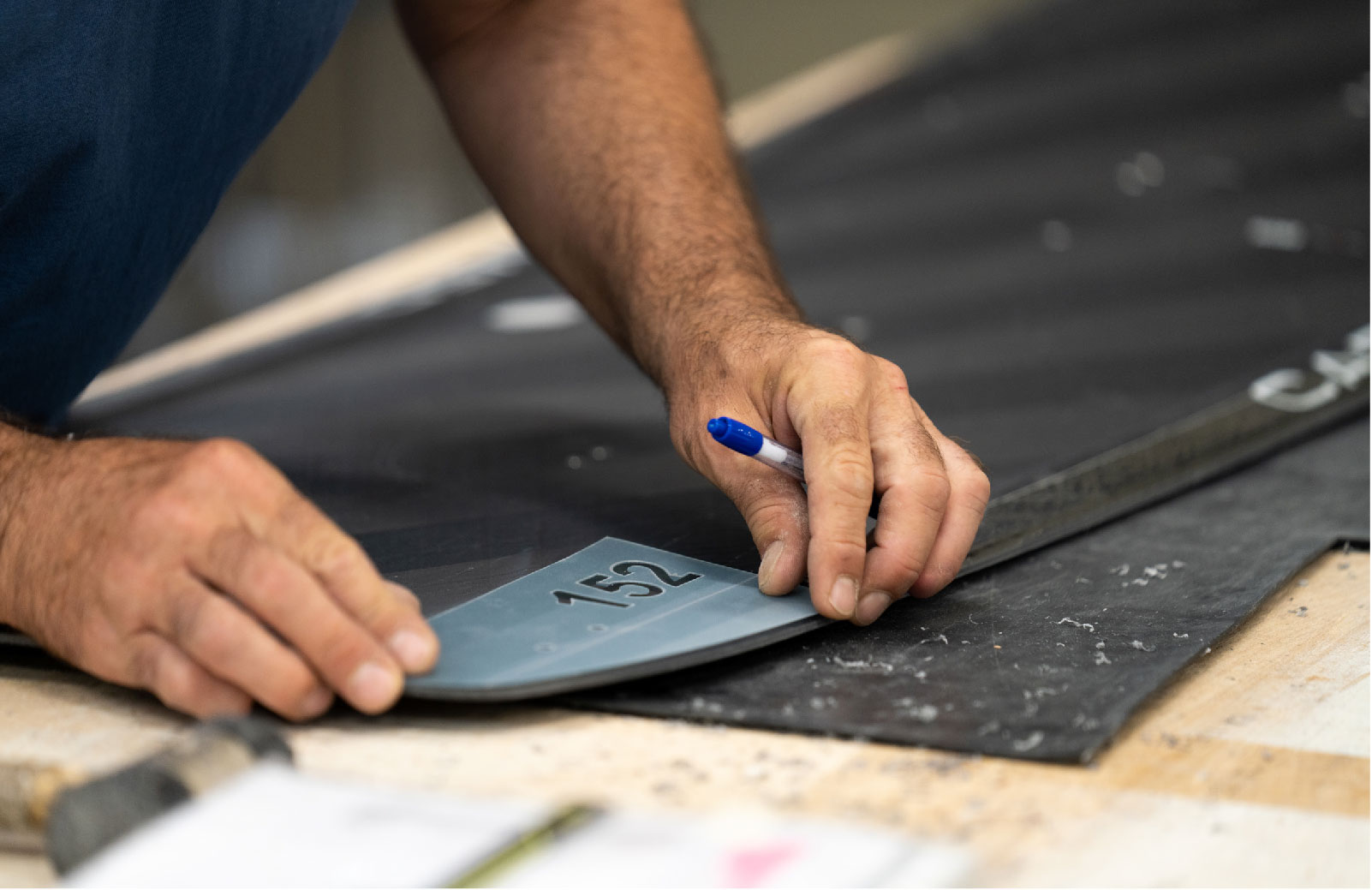 Carved has always been a custom affair with tradesmen building precision kiteboards buttressed by the stone walls of an old train depot on the island of Fehmarn, Germany. When the rest of the industry focused on offshoring and scaling production, the Carved factory remained a craftsman’s refuge focused on generating only the highest quality boards with the best carbon technology available. This year, the Imperator 7 is being released with substantial changes to the materials and design, but above all else, Carved is taking the groundbreaking step of migrating its tradesman-oriented manufacturing process to a new state-of-the-art facility in Slovenia. Integrating their hands-on craftsman process with robotic and industrial technology presents a new chapter in the legacy of Europe’s premier carbon kiteboard.
Carved has always been a custom affair with tradesmen building precision kiteboards buttressed by the stone walls of an old train depot on the island of Fehmarn, Germany. When the rest of the industry focused on offshoring and scaling production, the Carved factory remained a craftsman’s refuge focused on generating only the highest quality boards with the best carbon technology available. This year, the Imperator 7 is being released with substantial changes to the materials and design, but above all else, Carved is taking the groundbreaking step of migrating its tradesman-oriented manufacturing process to a new state-of-the-art facility in Slovenia. Integrating their hands-on craftsman process with robotic and industrial technology presents a new chapter in the legacy of Europe’s premier carbon kiteboard.
The origin of the Imperator 7 starts with the basic maxim of product development in the Carved and Core family; product releases occur only when there is an improvement””and for Carved, it has to be a big improvement. The Imperator 6 had achieved near perfection and was largely celebrated for its agile and fast performance, but there was a dedicated base of riders that were looking for more control at high-end speeds. With the introduction of the Cartan 2 carbon fiber material, the shared engineering department between Carved and Core began to experiment with its innovative fiber weave and lower resin needs. This new, lighter and stronger material kicked off a lengthy development process to reengineer the Imperator from the ground up.

Carved’s production Manager, Marc Schütze, attends to the finest details. Marc handles everything from production quality control to Carved’s customer service to ensure the legacy of quality and craftsmanship continues. // Photo Oliver Raatz
When you have a new material, the first logical step is to apply it to the previous version of the board and observe the differences. With sheets of Cartan 2 wrapped around the existing Imperator 6 chassis, the development team found impressive reductions in weight that were very encouraging. The new Cartan 2 material features untwisted, straighter carbon fiber strands which change the thickness of the material and the behavior of the fibers. The material itself is lighter, but when you laminate multiple levels of carbon together, you get a deck that absorbs significantly less resin and wind up with a reduction in weight of 100 grams per square meter.
Excited by their early layup results, the design team took the first prototypes to the water to run them through the shakedown process. Since the Imperator is a world-renowned board with a niche following of highly loyal and performance-obsessed twin tip riders, the Imperator feeling encompasses a very specific set of qualities. Unfortunately, very few of those qualities were present in the first prototype board. The flex pattern exhibited a pounding sensation through mild chop and the material offered terrible control at high-end speeds. As Production Manager for Carved, Marc Schütze oversees everything from development to manufacturing and customer service at the company. As far as he was concerned, if the Imperator is known for setting the highest bar, the first prototype wasn’t even on the scale.

Steven Akkersdijk celebrates the ultra light weight of the Imperator 7 with this boned out tail grab. The Cartan 2’s candy stripes gleam against the sky. // Photo Thomas Burblies
One of the key methods used by the Carved development team is to find empirical data to back up the subjective feedback that comes from product testers. According to Jan Termöhlen, an engineer on the Imperator design team, “The impressions from your test riders can build a creative cloud around your product, and sometimes it helps to have numbers on your desk to cut through to the essence of feedback.” To understand the changes wrought by the new material, the design team built a 3-point jig that allowed them to test the board’s stiffness at any given point. By setting the jig and weighting areas of the board, they could test deflection and translate that to a baseline of stiffness. Having learned that the new material was 20% stiffer compared to the original Cartan, Jan and his team knew they had substantial improvements in weight, but they needed to redesign the flex pattern in the board’s wood core to meet the expectations of the Imperator’s fan base.

One of the benefits of relocating production to the Elan factory in Slovenia is more durable graphics embedded inside the board. // Photo Oliver Raatz
Using the basic Imperator formula, they built a fleet of over 10 test boards, each with an experimental chassis fine-tuned to test a particular flex theory. With 12 internal test riders lining up to rotate through the arsenal, board #5 became the all-around resounding choice. By narrowing the thickness of the wood core, the design team had compensated for Cartan 2’s material strength and arrived at a point where the innate qualities of wood and glass began to work together. With the flex pattern largely nailed down, next, Core’s designers turned their attention to improving the board’s rail control at high speeds.
In the four years since the Imperator 6’s release, the design team has made significant discoveries in rail technology while working with the Core line of boards. If the goal was to fine-tune the Imperator’s performance at higher speeds, they would need to change the rail outline and encourage the board to sit lower in the water, but they would have to accomplish this without adding drag. The rail line going into the tips was made straighter until the high-speed handling felt significantly more stable. Since the rails feature a tucked-under profile that generates a perpendicular force sucking the board down into the water, they needed to find the perfect balance between this extra-grippy force and the unwanted drag that comes with it. By adjusting the shape of the tucked rail and working in a harder edge, the engineers could encourage water release that tempers the drag that is created by the suction. The result was a board that still feels incredibly fast and agile, but when you push the new Imperator 7 into the high-end speed range, it has more control than before and inspires greater confidence through the hardest charging carves and big air sends.

The new manufacturing process is a combination of Carved’s time-honored craftsman techniques and new technologies employed in the Elan factory. With 80% less material waste, the shift to new materials and technology is a substantial improvement. // Photos Oliver Raatz
In addition to the obvious performance improvements from the new materials, moving the Imperator’s production to the Elan ski manufacturing facility has added additional precision to the company’s board building process. Having transported essential equipment from Carved’s facility in Fehmarn to the new manufacturing line in Slovenia, the new approach is a combination of the Imperator’s existing craftsmanship and the ski factory’s new technology. The Elan factory has the machines to digitally print the graphics below the glass so that Imperator riders will see more durable graphics as well as a reduction in drag. With new methods for pre-bending the wood cores, Marc can ensure that the rocker in each board comes off the line with exact precision. Incremental improvements like larger resin batches and sophisticated heat controls in industrial ovens, also increases the Imperator 7’s quality control. The factory uses a robot to precisely lay down each sheet of carbon fiber, perfectly trimmed to match the board’s template. This method cuts 80% of the waste out of the process, which is better for the customer, the landfill and the climate.

Every ounce counts in the freeride game; with its double to single concave bottom shape, the Imperator 7 offers both precision and comfort at the flick of a tip. // Photo Lutz Englert
Early on in the Imperator 7 redesign process, the development team began experimenting with a new rocker modification device that offered the ability to flatten the rocker for better light wind performance. As a patented technology, Core’s Rick Jensen took the Revo mechanism and designed an ergonomic frame that would fit with the Imperator 7. The Revo offers two riding modes to choose from: the normal setting is neutral, where the board features its standard rocker and flex, but if you twist the handle, it then flattens the board out, removing the rocker and increasing the board’s upwind and low wind efficiency. The Imperator 7’s v-rocker and double to single concave bottom shape give it incredible chop handling capabilities during powered riding, but the Revo’s rocker-flattening setting provides more range when the wind isn’t quite as strong. After significant durability testing, the designers made some changes to the handle’s mounting points to ensure the Revo didn’t compromise the strength and longevity of the board.

Capturing the speed of a machine. // Photo Oliver Raatz
Since every aspect of the board was under the microscope, the design team swapped all the pad and strap hardware from the Phillips crosshead screws to T30 Torx drivers. Saying goodbye to the Phillips head was easy because, according to Jan, “The Phillips head screws require extensive push-down force to get sufficient tension and the heads are prone to stripping without proper technique.” Since kitefoiling equipment has embraced the T30, these tools are quite easily found at beaches around the world, and it seemed like the perfect time to make the commonsense swap.

Steven Akkersdijk putting the final version of prototype #5 into action. // Photo Thomas Burblies
With regard to the actual accessories, the team took Core’s Union Pro 4 footpad and made some specific changes for the Imperator 7, increasing the contours in the footbed to be a bit more aggressive while the pad material was made softer to allow the foot to compress into the footbed. The straps were completely redesigned to improve the functionality of the tensioning ratchet, and by changing the ergonomics of the pad’s inner frame, the strap better matches the asymmetric arch of the human foot. The Imperator reboot was finished off with upgraded fins that were precision-tweaked to match the board’s rocker line with an updated outline and profile that reduces drag.

Using a jig to get every inch of the rail perfect. // Photo Oliver Raatz
No stone was left unturned on the reinvention of the Imperator 7, and when the product was finally released in August and exhibited at this year’s Kitesurf Masters in St Peter-Ording, the development team watched the product reel for the first time. With a custom-scored music track synced to each frame, the team viewed their hard work with tremendous pride as shots of the new manufacturing process flashed between a quick succession of explosive action riding clips. Having evolved into a prestige product for demanding riders worldwide, the Imperator 7, with its new build, lighter weight and tuned-up performance, has once again established its apex status amongst twin tip products.

This article was featured in our fall 2021 issue, Vol. 18, No. 3. To read more, click here.
Or thumb through each article individually below:
Features:

